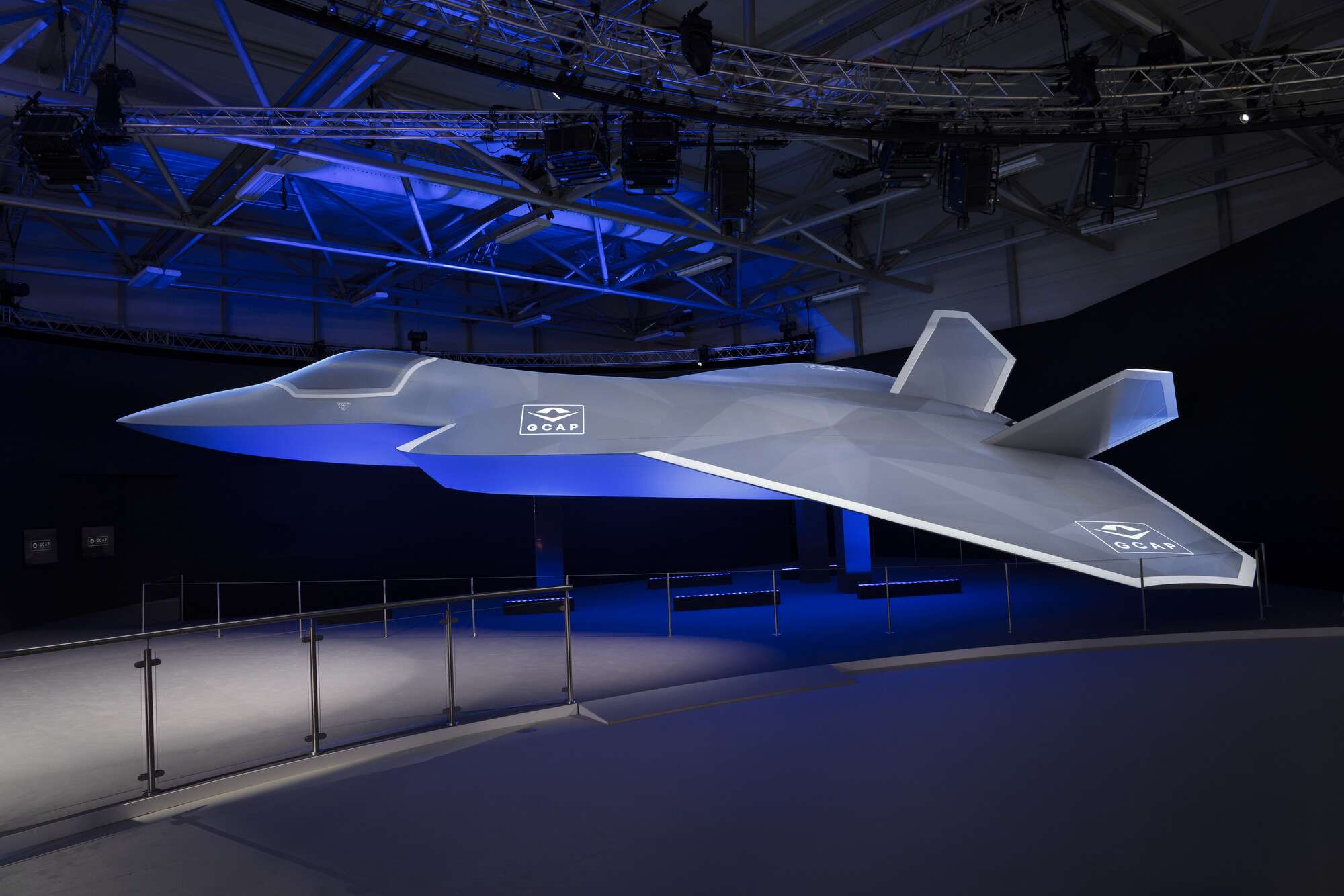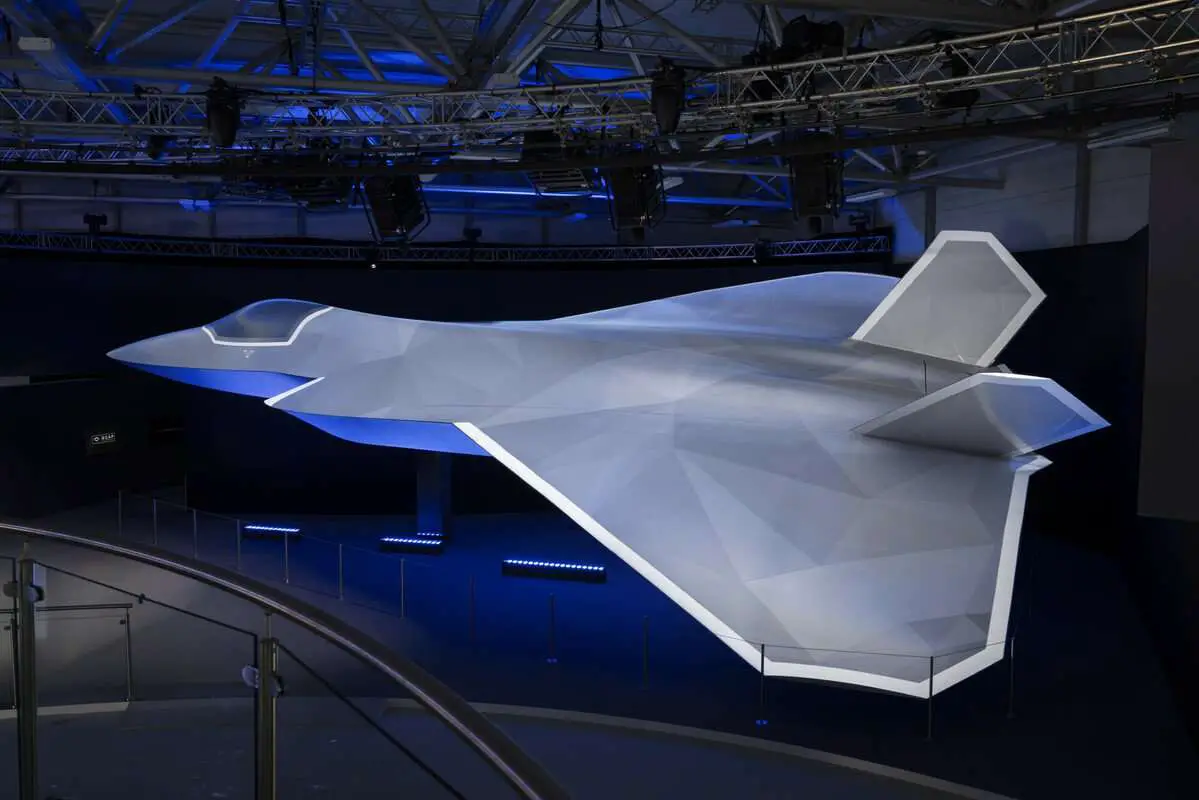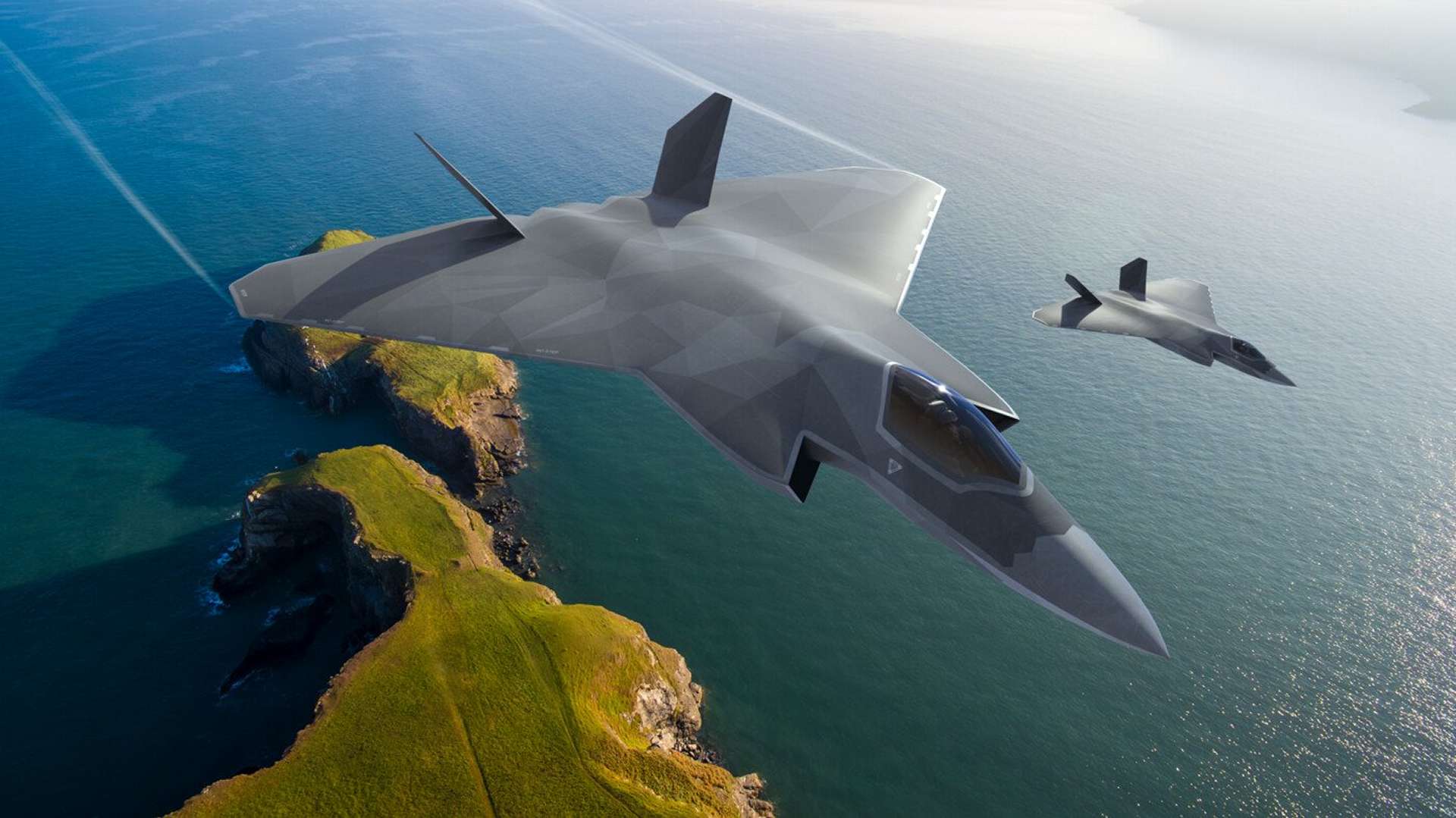GCAP partners reveal new fighter jet design at Farnborough Airshow

{loadposition bannertop}
{loadposition sidebarpub}
On July 22, 2024, the Global Combat Air Programme (GCAP) partners (UK, Italy, and Japan) presented a new concept model of their next-generation combat aircraft at the Farnborough International Airshow 2024. his was the first joint exhibition by the three GCAP government partners and their lead industry partners, BAE Systems (UK), Leonardo (Italy), and Mitsubishi Heavy Industries (Japan), showcasing progress towards developing a next-generation combat aircraft.Follow Army Recognition on Google News at this link
Displayed at the Farnborough International Airshow 2024, the new concept model has an evolved design with a larger wingspan to improve the aerodynamics of the future GCAP combat aircraft. (Picture source: BAE Systems)
Displayed in Hall 5, the new concept model has an evolved design with a larger wingspan to improve the aerodynamics of the future combat aircraft. Engineers from BAE Systems, Leonardo, and Mitsubishi Heavy Industries are collaborating under a formal agreement, using advanced digital tools and techniques, including computer-based modeling and virtual reality, to refine the aircraft’s design during its conceptual phase.
Since the launch of GCAP 18 months ago, partners have worked closely with their respective governments to align requirements for a next-generation combat aircraft. The unveiling at the Farnborough International Airshow marks progress in this alignment. Herman Claesen, Managing Director of Future Combat Air Systems at BAE Systems, stated that the program is advancing rapidly, building on a solid foundation and strong government partnerships. He mentioned that the new model reflects ongoing testing and design evolution, which are essential as the program moves forward.
Guglielmo Maviglia, Chief Global Combat Air Programme Officer at Leonardo, emphasized the program’s significance for Italy and its industrial sector. He mentioned that each partner is strongly committed to GCAP, which represents the future of combat air within a comprehensive system perspective. Hitoshi Shiraishi, Senior Fellow at Mitsubishi Heavy Industries, noted the opportunity GCAP offers to combine different cultures, experiences, and expertise from the three countries. He expressed hopes that the program would promote innovation and digital transformation within Japan’s industrial sector and support the development of human resources in science and technology.
The next-generation combat aircraft, expected to enter service by 2035, aims to be an advanced, interoperable, and adaptable fighter jet. It will include an intelligent weapons system, a software-driven interactive cockpit, integrated sensors, and a next-generation radar capable of providing more data than current systems, offering a significant advantage.
This program aims to replace the Eurofighter Typhoon in service with both the Royal Air Force (RAF) and the Italian Air Force, and the Mitsubishi F-2 in service with the Japan Air Self-Defense Force. (Picture source: Twitter/Tim Robinson)
The Global Combat Air Programme (GCAP), emerging from the merger of the UK-led BAE Systems Tempest, developed with Italy, and the Japanese Mitsubishi F-X programs, was officially announced on December 9, 2022, and formalized with a treaty signed in December 2023. The program plans to start the formal development phase in 2025, with a demonstrator flight expected by 2027, and production aircraft entering service by 2035.
Led by these three countries to jointly develop a sixth-generation stealth fighter, this program aims to replace the Eurofighter Typhoon in service with both the Royal Air Force (RAF) and the Italian Air Force, and the Mitsubishi F-2 in service with the Japan Air Self-Defense Force.
Discussions for both parties to combine their respective fighter development efforts began as early as 2017. The GCAP program is crucial for the security, political, and economic interests of each nation involved, as well as for reducing development costs and achieving shared military objectives. It will also provide important sovereign combat air capabilities for future generations through effective knowledge and technology transfer.
The program is expected to employ tens of thousands of skilled professionals across the three countries, fostering the growth of industrial skills and technologies. Currently, approximately 9,000 people are working on the project worldwide, and over 1,000 suppliers from the three partner nations. 600 suppliers are based in the UK, and 400 are based in Italy and Japan. Additionally, BAE Systems has 1,000 apprentices and graduates working on the GCAP.
The program envisages an equal partnership, with BAE Systems handling the airframe, Rolls-Royce the engines, Leonardo’s UK division the electronics, and MBDA UK the weapons. In Japan, Mitsubishi Heavy Industries is the prime contractor, with IHI Corporation handling the engines and Mitsubishi Electric handling the electronics. In Italy, Leonardo S.p.A. is the prime contractor, with Avio Aero working on the engines and MBDA IT on missile development. Detailed development and cost sharing will be clarified by 2024, with production beginning around 2030.
Speculation has arisen about potential membership from Sweden, Saudi Arabia, and Germany. Sweden signed an agreement with Japan in December 2022, but there are doubts about alignment with GCAP. Saudi Arabia has expressed interest, but Japan is opposed due to concerns about technology security and domestic defense export policies. Germany is rumored to consider joining GCAP amid challenges with the Future Combat Air System program, though this remains speculative.
The GCAP will include an intelligent weapons system, a software-driven interactive cockpit, integrated sensors, and a next-generation radar capable of providing more data than current systems, offering a significant advantage. (Picture source: BAE Systems)

{loadposition bannertop}
{loadposition sidebarpub}
On July 22, 2024, the Global Combat Air Programme (GCAP) partners (UK, Italy, and Japan) presented a new concept model of their next-generation combat aircraft at the Farnborough International Airshow 2024. his was the first joint exhibition by the three GCAP government partners and their lead industry partners, BAE Systems (UK), Leonardo (Italy), and Mitsubishi Heavy Industries (Japan), showcasing progress towards developing a next-generation combat aircraft.
Follow Army Recognition on Google News at this link
Displayed at the Farnborough International Airshow 2024, the new concept model has an evolved design with a larger wingspan to improve the aerodynamics of the future GCAP combat aircraft. (Picture source: BAE Systems)
Displayed in Hall 5, the new concept model has an evolved design with a larger wingspan to improve the aerodynamics of the future combat aircraft. Engineers from BAE Systems, Leonardo, and Mitsubishi Heavy Industries are collaborating under a formal agreement, using advanced digital tools and techniques, including computer-based modeling and virtual reality, to refine the aircraft’s design during its conceptual phase.
Since the launch of GCAP 18 months ago, partners have worked closely with their respective governments to align requirements for a next-generation combat aircraft. The unveiling at the Farnborough International Airshow marks progress in this alignment. Herman Claesen, Managing Director of Future Combat Air Systems at BAE Systems, stated that the program is advancing rapidly, building on a solid foundation and strong government partnerships. He mentioned that the new model reflects ongoing testing and design evolution, which are essential as the program moves forward.
Guglielmo Maviglia, Chief Global Combat Air Programme Officer at Leonardo, emphasized the program’s significance for Italy and its industrial sector. He mentioned that each partner is strongly committed to GCAP, which represents the future of combat air within a comprehensive system perspective. Hitoshi Shiraishi, Senior Fellow at Mitsubishi Heavy Industries, noted the opportunity GCAP offers to combine different cultures, experiences, and expertise from the three countries. He expressed hopes that the program would promote innovation and digital transformation within Japan’s industrial sector and support the development of human resources in science and technology.
The next-generation combat aircraft, expected to enter service by 2035, aims to be an advanced, interoperable, and adaptable fighter jet. It will include an intelligent weapons system, a software-driven interactive cockpit, integrated sensors, and a next-generation radar capable of providing more data than current systems, offering a significant advantage.

This program aims to replace the Eurofighter Typhoon in service with both the Royal Air Force (RAF) and the Italian Air Force, and the Mitsubishi F-2 in service with the Japan Air Self-Defense Force. (Picture source: Twitter/Tim Robinson)
The Global Combat Air Programme (GCAP), emerging from the merger of the UK-led BAE Systems Tempest, developed with Italy, and the Japanese Mitsubishi F-X programs, was officially announced on December 9, 2022, and formalized with a treaty signed in December 2023. The program plans to start the formal development phase in 2025, with a demonstrator flight expected by 2027, and production aircraft entering service by 2035.
Led by these three countries to jointly develop a sixth-generation stealth fighter, this program aims to replace the Eurofighter Typhoon in service with both the Royal Air Force (RAF) and the Italian Air Force, and the Mitsubishi F-2 in service with the Japan Air Self-Defense Force.
Discussions for both parties to combine their respective fighter development efforts began as early as 2017. The GCAP program is crucial for the security, political, and economic interests of each nation involved, as well as for reducing development costs and achieving shared military objectives. It will also provide important sovereign combat air capabilities for future generations through effective knowledge and technology transfer.
The program is expected to employ tens of thousands of skilled professionals across the three countries, fostering the growth of industrial skills and technologies. Currently, approximately 9,000 people are working on the project worldwide, and over 1,000 suppliers from the three partner nations. 600 suppliers are based in the UK, and 400 are based in Italy and Japan. Additionally, BAE Systems has 1,000 apprentices and graduates working on the GCAP.
The program envisages an equal partnership, with BAE Systems handling the airframe, Rolls-Royce the engines, Leonardo’s UK division the electronics, and MBDA UK the weapons. In Japan, Mitsubishi Heavy Industries is the prime contractor, with IHI Corporation handling the engines and Mitsubishi Electric handling the electronics. In Italy, Leonardo S.p.A. is the prime contractor, with Avio Aero working on the engines and MBDA IT on missile development. Detailed development and cost sharing will be clarified by 2024, with production beginning around 2030.
Speculation has arisen about potential membership from Sweden, Saudi Arabia, and Germany. Sweden signed an agreement with Japan in December 2022, but there are doubts about alignment with GCAP. Saudi Arabia has expressed interest, but Japan is opposed due to concerns about technology security and domestic defense export policies. Germany is rumored to consider joining GCAP amid challenges with the Future Combat Air System program, though this remains speculative.

The GCAP will include an intelligent weapons system, a software-driven interactive cockpit, integrated sensors, and a next-generation radar capable of providing more data than current systems, offering a significant advantage. (Picture source: BAE Systems)





